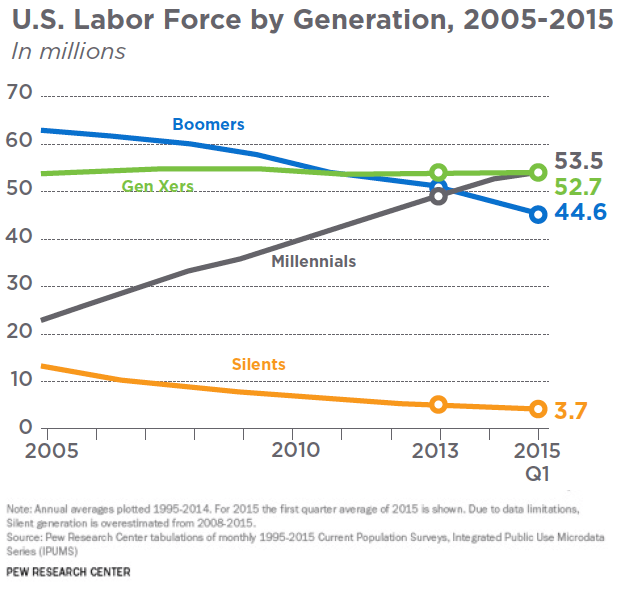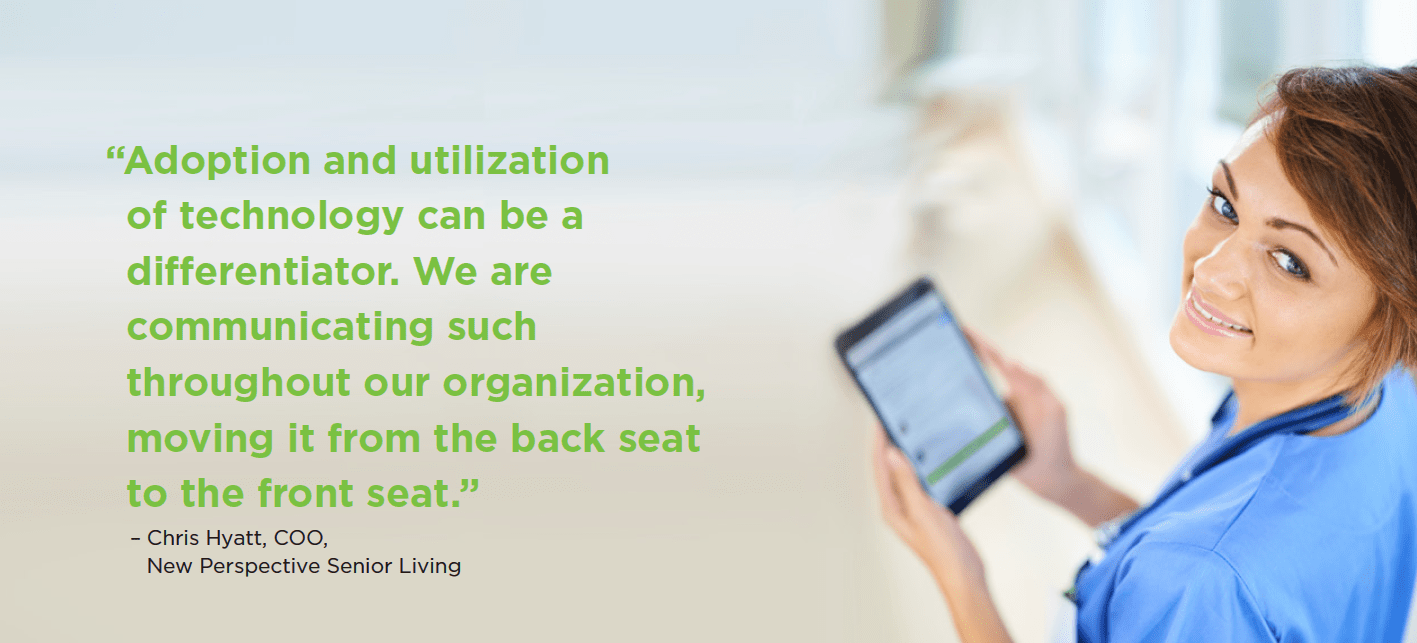A WHITEPAPER FROM ONSHIFT
As the population ages and a younger generation bolsters the employment landscape, the senior care workforce is experiencing a major shift.
More than a third of American workers are millennials—the generation defined as adults ages 20 to 36, according to the Pew Research Center. Since 2015, this age group comprises the largest share of the overall workforce. At the same time, unemployment in the United States is at a historically low level—around 4.4%, according to the Bureau of Labor Statistics. This combination of factors is creating new challenges for senior housing and care providers in managing their greatest asset: people.
Retention Is More Than Wage Increases

“The workforce needs are changing,” says Chris Stach, director of HR support and development for Altercare of Ohio, a post-acute care provider with 20 locations in Ohio and Michigan. “We constantly ask what can we do to meet these needs.”
“The workforce challenge is the biggest issue in our business right now.” – Ryan Novaczyk, president and CFO, New Perspective Senior Living
“It’s a change that presents both a challenge and an opportunity,” says Ryan Novaczyk, president and CFO of New Perspective Senior Living, an operator of 21 senior living communities in Minnesota, North Dakota, Wisconsin, and Illinois.
“The workforce challenge is the biggest issue in our business right now,” Novaczyk says. “That includes finding the right people, making sure we are fully staffed, getting them trained and on-boarded, retaining them and providing career paths. This is something we as an industry have not done well historically. We view this as a huge opportunity and are investing in addressing these issues.” Key to a stable and consistent workforce is retaining workers, which continues to be an issue for senior care providers across the country. High turnover rates continue to plague the industry, which some estimate at 50% – or higher, particularly in the first three months of employment.

Simply providing a paycheck and job description is not enough to retain today’s workforce, as employees refuse to settle for the status quo. With a thriving economy and unemployment at historic lows, the retention challenge is heightened. Providers must up their engagement and retention strategies to compete. “We have a lot of work to do in terms of setting a new standard, but we are not happy with the status quo,” Novaczyk says. “Wages are important,” he added, “but so is making team members feel valued, giving them an opportunity to provide input into decisions, providing education and career advancement opportunities, and utilizing a rewards program to help improve retention.” New Perspective Senior Living’s chief of operations Chris Hyatt says, “An extraordinary culture is a big reason why people stay—which increases the success with retention.” Culture starts with making employees feel valued, from active listening and expedient follow-up, to the dress code, working conditions, amenable scheduling options, to paths for growth. “Particularly in senior care, there are substantial retention challenges across the front line,” Hyatt
says, “which includes caregivers, dining staff, and housekeeping.”
“They can go down the street to a coffee shop and make a similar wage as those directly serving our residents,” Hyatt says. “We know there can be an elevated stress level involved when taking care of a person versus serving a latte. That’s why we are focused on creating a meaningful environment that’s enriching; from frequent all employee engagement meetings with senior management to investing in technology to make their job as efficient as possible.” Providing these tools and a basic level of comfort to employees drives productivity, too, leading to bottom line results.
Rising Labor Costs In A More Competitive Market
Due to a nearly full-employment economy and rising wages in several states, labor cost is a top issue facing senior care providers. While this phenomenon varies by market, with states like California and New York moving toward a $15-per-hour minimum wage, it’s largely affecting every part of the hiring process from recruiting to retention. It’s also hitting the bottom line. “From 2008 to about 2014, we experienced relatively low wage growth and we were able to hold total costs about the same (<3%) while still slowly growing revenue per resident or per unit, ahead of those costs,” Hyatt says. “Just in the last few years it seems like I take a few phone calls every month from a community needing an additional dollar here or there to be more wage competitive. Obviously, we challenge their assumptions and work collaboratively to come to a fruitful solution, but it seems to be more so than ever.” Senior care companies aren’t just competing with other players in the field for employees; they’re fighting retailers and restaurants to find the best hourly workers available.
“Retailers today can throw money at the problem,” Novaczyk says. “Every time a new retailer enters a market we are in, or an existing one changes their starting wages, we risk losing a few of our folks.” But that ability is likely to change in the coming years as technology changes the retail business. “With Amazon Go (new automated checkout store) and Amazon’s recent acquisition of Whole Foods, changes could be here sooner than many think,” he adds. “Retailers in general will be forced to respond to what Amazon is doing and that could free up thousands of prospective employees in any given market.”
The Tech Advantage
Attracting workers to senior care, including millennials, is the key to success. Today’s new graduates and the millennial workforce have grown up in the era of information and technology. For them, it’s not an option, it’s a necessity. Providers should tout their technology solutions
from the first day of the interview process to show prospective workers how technology can make their jobs—and their lives—easier. “We are trying to attract more college students and new grads,” says Hyatt. “They don’t want to use a number-two pencil or a spreadsheet. They come in super excited about combining technology with care and hospitality.” “Adoption and utilization of technology can be a differentiator. We are communicating such throughout our organization, moving it from the back seat to the front seat.” Despite the challenges in the senior living workforce, operators have major opportunities to implement interesting technologies in their labor management practices. “We are living in a time powered by technology and fueled by information,” Stach says. “Altercare has made a lot of investments in technology, and it is up to us to position ourselves for the future.”

Both New Perspective Senior Living and Altercare of Ohio use OnShift Software to manage their employees. With OnShift, managers easily identify areas of inefficiency so they can address them quickly. “OnShift scheduling allows us to measure key labor metrics,” Stach says. “For example, prior to OnShift, we had a problem with employees clocking in early or leaving late. We didn’t have a good report for it and we couldn’t measure it. With OnShift, we can now measure it and be more proactive. Technology is a huge piece for us.”
In addition, both organizations are using technology to meet the demands of today’s workforce by providing their staff with a better work-life balance. This was difficult using their previous manual scheduling processes. Now with OnShift’s mobile app, staff have more scheduling control and can easily set work preferences, availability, request open shifts and time-off, swap shifts and be instantly notified of changes.
“Allowing our employees to have a say in their work days and hours, as well as providing fair and equal access to open shifts can have a big impact on engagement at the individual level. It sends a message to an employee that an organization feels their input matters,” notes Hyatt. “And the impact that can have on culture as a whole is significant.”
OnShift not only helps to improve efficiencies from an operational and scheduling standpoint, but bridges the gaps that commonly exist between managers, supervisors, schedulers and employees by providing a system that better facilitates communication and scheduling visibility.
OnShift’s newest software, OnShift Engage, utilizes quick hit pulse surveys to solicit employee feedback and measure satisfaction in real-time, recognizes
and rewards staff for their contributions, and tracks employee work habits to prompt managers to check-in with their employees. “What OnShift Engage really allows us to do is to leverage the information that we already have in the system,” says Stach. “We’re looking at the attendance data, the performance data, and it’s letting us take action, and have better conversations with employees to engage them, motivate them, and really align it with incentives to hopefully retain them for the future.”
About OnShift, Inc.
OnShift delivers cloud-based human capital management software and proactive services to solve everyday workforce challenges in healthcare. Our suite of products for hiring, scheduling and employee engagement drives quality care, lower costs and higher performance by empowering providers to staff consistently and efficiently. Intuitive design, predictive analytics and customer success management are why thousands of post-acute care and senior living organizations rely on OnShift. For more information visit www.onshift.com.



